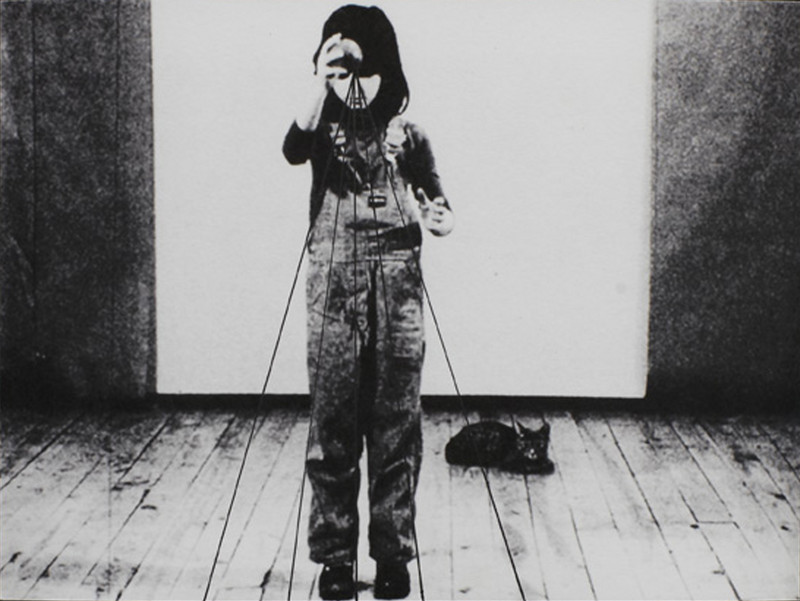Émilie Pitoiset / Hanna Schwarz
24 Jan - 01 Apr 2013
In its atrium Badischer Kunstverein is presenting the artists Émilie Pitoiset (b. 1980 in Noisy-le-Grand) and Hanna Schwarz (b. 1975 in Stuttgart) in a joint exhibition. Both artists set out from aspects of movement in dance, gestures, performances, and film narratives, but they do not foreground the movement itself but rather the moment between different body postures. They emphasize the in-between or gap as a place where meanings are generated.
Émilie Pitoiset works with photography, film, installation, and objects. Her works usually start with found images such as photographs, film stills, or excerpts from films. For example, the series of photographs titled Giselle shows gymnasts practicing various exercises at the moment just before they relax the tension in their bodies and the pose collapses. On these found photographs, Pitoiset has drawn in lines that mark the resting point and the movement that results from imbalance. Pitoiset studies these images with an eye to their narrative instability. What action preceded the moment captured and what will follow it? What happened in between? Pitoiset plays with the fact that the meaning of objects and scenes cannot be explained by the facts they record. Their scenarios represent the transition from reality to fictional projection. The viewer is hereby confronted with the limits of his or her perception and the tipping point between truth and fiction.
Hanna Schwarz works in the media of film, sculpture, and drawing. In her films she takes dance performances, choreographies, and everyday movements and breaks them down into their elementary components, raising questions about the conditions under which movements such as dance or gesture can be categorized. In her cinematic work I Love The Body, Schwarz adopts dancer’s poses from a performance by Yvonne Rainer and maintains them in a kind of tableau vivant. These shots are interrupted by dancing and running legs, accompanied by the asynchronous sound of tap dancing. The pauses between the poses, the hesitating of the figures, and the usually asynchronous soundtrack accentuate the individual elements that are substantial for any choreography. In both repetition and imitation, there is a turning point that Schwarz also transfers to her sculptural objects and installations.
Both artists present the body as a kind of storage place for social actions. The undefined and unstable quality thus points to a utopian moment. At the same time, both artists also raise questions of historicizing dance and performances and translating dance and choreographies into other media such as film and photography.
With kind support from institut francais.
Hanna Schwarz is given the London grant of the Berlin Senate.
Émilie Pitoiset works with photography, film, installation, and objects. Her works usually start with found images such as photographs, film stills, or excerpts from films. For example, the series of photographs titled Giselle shows gymnasts practicing various exercises at the moment just before they relax the tension in their bodies and the pose collapses. On these found photographs, Pitoiset has drawn in lines that mark the resting point and the movement that results from imbalance. Pitoiset studies these images with an eye to their narrative instability. What action preceded the moment captured and what will follow it? What happened in between? Pitoiset plays with the fact that the meaning of objects and scenes cannot be explained by the facts they record. Their scenarios represent the transition from reality to fictional projection. The viewer is hereby confronted with the limits of his or her perception and the tipping point between truth and fiction.
Hanna Schwarz works in the media of film, sculpture, and drawing. In her films she takes dance performances, choreographies, and everyday movements and breaks them down into their elementary components, raising questions about the conditions under which movements such as dance or gesture can be categorized. In her cinematic work I Love The Body, Schwarz adopts dancer’s poses from a performance by Yvonne Rainer and maintains them in a kind of tableau vivant. These shots are interrupted by dancing and running legs, accompanied by the asynchronous sound of tap dancing. The pauses between the poses, the hesitating of the figures, and the usually asynchronous soundtrack accentuate the individual elements that are substantial for any choreography. In both repetition and imitation, there is a turning point that Schwarz also transfers to her sculptural objects and installations.
Both artists present the body as a kind of storage place for social actions. The undefined and unstable quality thus points to a utopian moment. At the same time, both artists also raise questions of historicizing dance and performances and translating dance and choreographies into other media such as film and photography.
With kind support from institut francais.
Hanna Schwarz is given the London grant of the Berlin Senate.

